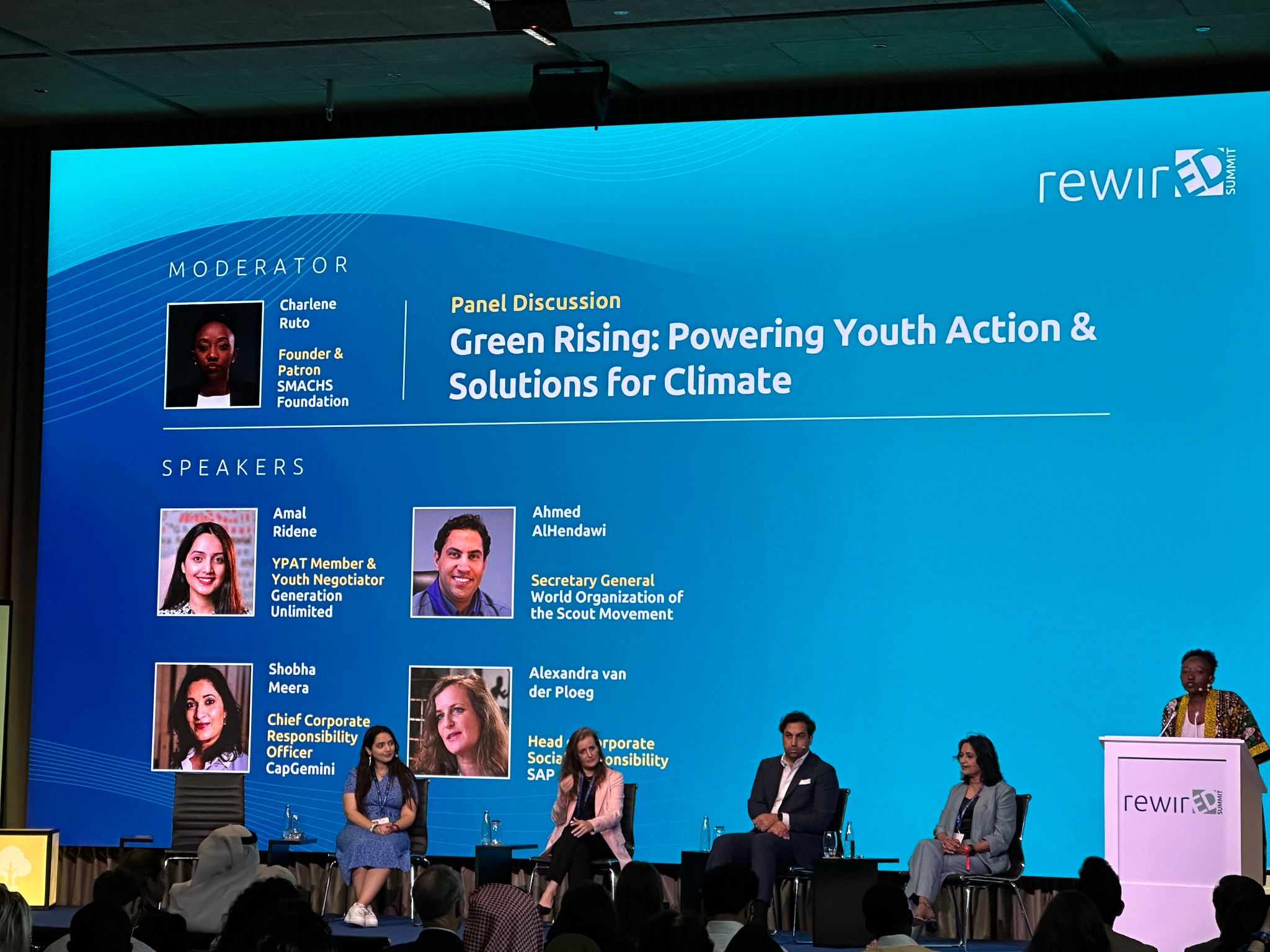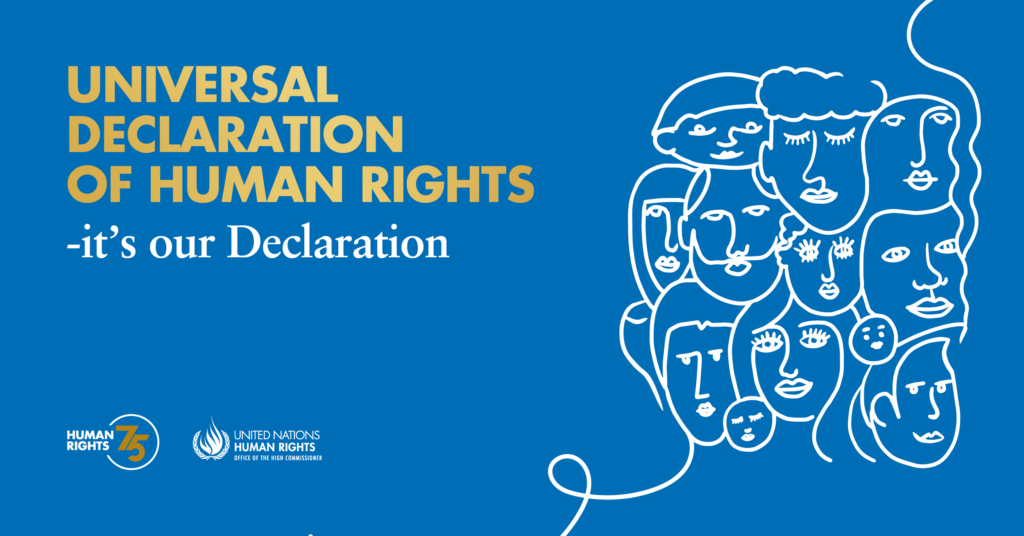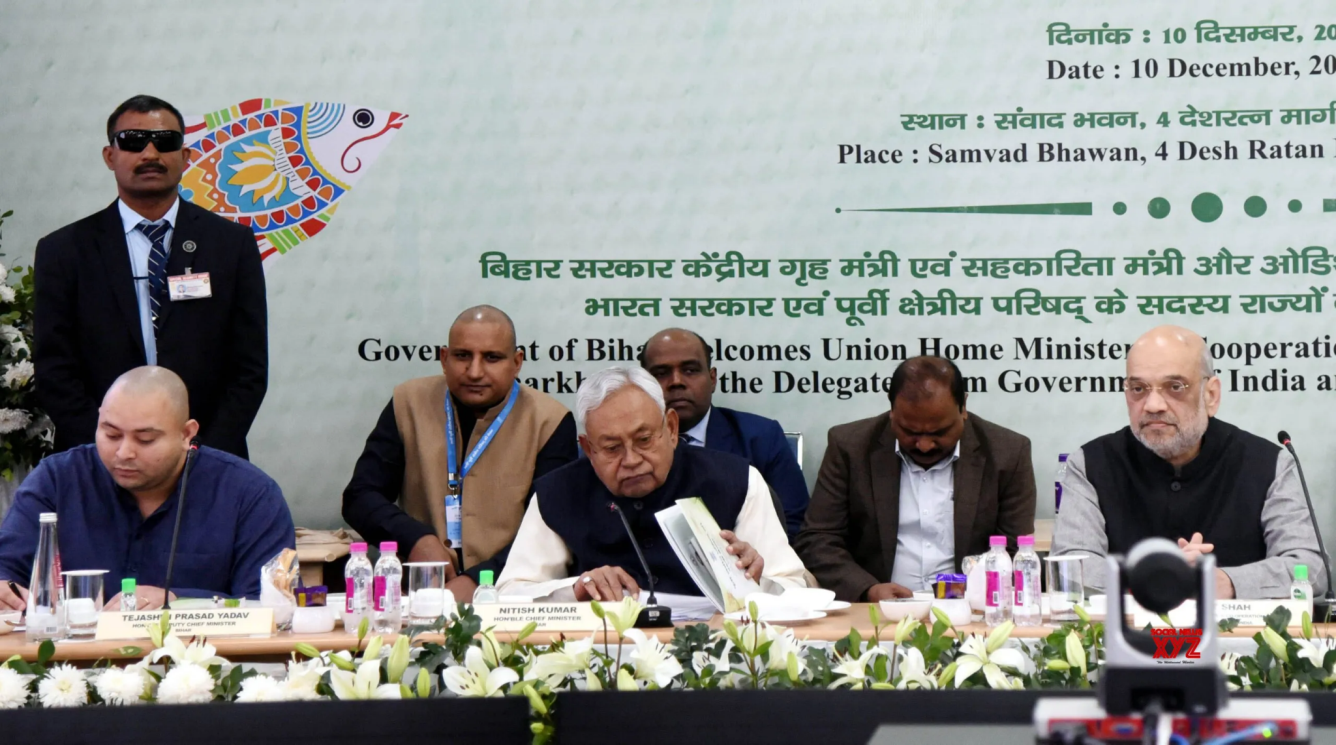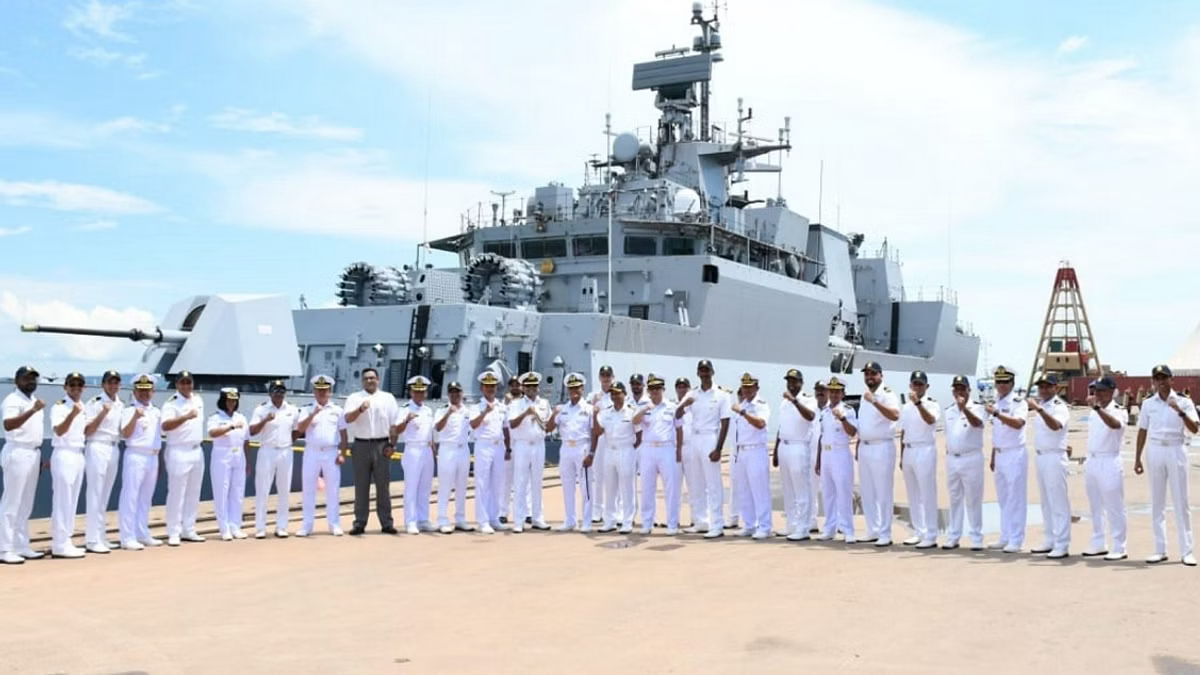Green Rising initiative launched at RewirEd summit to empower Youth-Led climate solutions (DD News)

- 09 Dec 2023
What is the Green Rising Initiative?
- The "Green Rising" initiative focuses on engaging youth for impactful environmental actions at the grassroots level, aligning with the global effort to address the severe impacts of climate change.
- This initiative encompasses both the global "Green Rising" initiative and the "Green Rising India Alliance," a collaborative endeavor that brings together UNICEF, Generation Unlimited, and a diverse network of public, private, and youth partners.
- The primary objective is to mobilize millions of young individuals globally, encouraging their active engagement in green initiatives aimed at addressing and adapting to the profound impacts of climate change within their communities.
- In India, this effort is channelled through the YuWaah campaign, which specifically focuses on harnessing the energy and commitment of the youth to drive impactful environmental actions at the grassroots level.
About UNICEF:
UNICEF, or the United Nations International Children's Emergency Fund, is a specialized agency of the United Nations committed to promoting the well-being and rights of every child globally.
- Foundation and Establishment: Established in 1946 by the United Nations General Assembly, UNICEF was originally designed to provide emergency food and healthcare to children in countries devastated by World War II.
- Over time, UNICEF's scope evolved to include long-term developmental programs, focusing on education, healthcare, nutrition, clean water, sanitation, and protection for children in need.
- UNICEF is governed by an Executive Board consisting of 36 members who are elected to terms of three years by the United Nations Economic and Social Council.
- Universal Presence: UNICEF operates in over 190 countries and territories worldwide, making it one of the most extensive and widely recognized humanitarian organizations globally.
- Child Rights Advocacy: UNICEF is a leading advocate for children's rights, working to ensure that every child has the right to survive, thrive, and reach their full potential, regardless of their background or circumstances.
- Emergency Response: In times of crises, including natural disasters, conflicts, and pandemics, UNICEF plays a crucial role in providing immediate and life-saving assistance to affected children and communities.
- Partnerships and Collaborations: UNICEF collaborates with governments, non-governmental organizations (NGOs), other UN agencies, and the private sector to implement its programs and maximize its impact.
- Funding Mechanism: UNICEF is funded entirely by voluntary contributions from governments, private donors, businesses, and the general public. It relies on these funds to carry out its programs and respond to emergencies.
- Focus on Equality and Inclusion: UNICEF emphasizes the importance of equality and inclusion, working to address disparities and ensure that the most vulnerable children, including those with disabilities or from marginalized communities, are not left behind.
- Global Campaigns: UNICEF spearheads global campaigns to address critical issues affecting children, such as vaccination drives, education initiatives, and efforts to eliminate child labour and violence against children. These campaigns aim to rally public support and create awareness about the challenges faced by children worldwide.
- It was awarded the Nobel Prize for Peace in 1965 for the “promotion of brotherhood among the nations”.
- Headquarters: New York City
India is expected to withstand global shocks as its current account deficit improves due to falling crude oil prices. (ET)

- 09 Dec 2023
Why is it in the News?
After two years of battling inflation and growth pangs, the Reserve Bank of India (RBI) was in for a pleasant surprise when the economic growth trumped its expectations to hit 7.2 per cent in the last month.
Context:
- The Reserve Bank of India (RBI) has unveiled its most recent monetary policy report, projecting a robust economic recovery for the country in the current fiscal year.
- Anticipating a significant upswing, the central bank foresees the gross domestic product (GDP) to expand by 7 percent in 2021-22, a notable rebound from the 7.3 percent contraction witnessed in the preceding year.
- However, the RBI issues a cautionary note about the challenges posed by inflation, which has consistently exceeded the target range of 2-6 percent over several months.
- The report attributes inflationary pressures to supply-side disruptions, escalating commodity prices, increased fuel taxes, and demand-related factors.
- The RBI anticipates inflation to remain elevated in the short term before gradually moderating in the latter half of the year.
- The RBI's stance mirrors a delicate equilibrium, emphasizing the intricate balance between fostering economic growth and managing inflation, often characterized as the Goldilocks Effect.
- This effect alludes to a scenario where the economy is neither excessively overheated nor excessively sluggish but rather poised for optimal growth with minimal inflationary pressures.
What is the Goldilocks Effect?
- The Goldilocks Effect, also known as the Goldilocks Principle, posits that individuals have a predisposition to seek an amount that is 'just right' for their specific needs or preferences.
- This concept, derived from the children's story of Goldilocks and the Three Bears, reflects a preference for options that are neither too extreme nor too moderate, falling within an optimal and desirable range.
- This principle finds application across various fields and disciplines, encompassing psychology, hard sciences, economics, marketing, and engineering, each incorporating its unique interpretation of the principle.
- Goldilocks Pricing: One notable application of the Goldilocks Effect is in Goldilocks Pricing, a psychological pricing strategy grounded in concepts such as product differentiation, comparative pricing, and bracketing.
- Product differentiation involves distinguishing certain products from others, a crucial step for businesses looking to leverage the Goldilocks Effect.
- This differentiation is then coupled with comparative pricing, where businesses simultaneously offer multiple versions of a product with varying quality levels attached to corresponding price points.
- The strategy hinges on providing three options: one priced too high for most, one priced too low for most, and one priced just right.
- When executed effectively, this approach enables businesses to appeal to diverse segments of the market, capturing premium buyers, standard consumers, and discount seekers.
What is the Universal Declaration of Human Rights, which is marking its 75th anniversary? (Indian Express)

- 09 Dec 2023
Why is it in the News?
Seventy-five years ago on Sunday, the UN General Assembly approved the Universal Declaration of Human Rights at a meeting in Paris – laying one of the foundation stones of the international order that emerged following the horrors of World War II.
What is the Universal Declaration of Human Rights (UDHR)?
- On 10 December 1948, during a session in Paris, the United Nations General Assembly unanimously endorsed the Universal Declaration of Human Rights (UDHR), marking a pivotal moment in shaping the post-World War II international order.
- The UDHR emerged as a response to wartime atrocities and aimed to establish a shared understanding of the fundamental rights and freedoms inherent to all individuals.
- A concise yet impactful document, the declaration comprises a preamble and 30 articles that delineate essential rights and freedoms.
- These 30 articles encompass a comprehensive spectrum of civil, political, economic, social, and cultural rights.
- Emphasizing their universality, these rights are deemed applicable to all individuals, irrespective of nationality, ethnicity, gender, religion, or any other status.
- While not legally binding, the UDHR has functioned as a guiding force inspiring the development of international human rights law.
Key Features:
- Preamble: The preamble elucidates the reasons behind adopting the declaration, underscoring the inherent dignity and the equal and inalienable rights of all members of the human family.
- Articles: The UDHR articulates 30 articles outlining a wide array of civil, political, economic, social, and cultural rights. Examples of these rights include:
- The right to life, liberty, and security of person.
- The right to freedom of religion, expression, and assembly.
- The right to work and education.
- The right to an adequate standard of living.
- The declaration asserts that "all are equal before the law" and emphasizes the entitlement of everyone to "a fair and public hearing by an independent and impartial tribunal."
- It also affirms the right of "everyone to seek and to enjoy in other countries asylum from persecution.
Achievements of UNDHR:
- The United Nations Universal Declaration of Human Rights (UNDHR) is acknowledged for its significant impact, having served as the inspiration and foundation for over 70 human rights treaties at both global and regional levels, as noted by the United Nations.
- It played a pivotal role in inspiring movements such as decolonization, the anti-apartheid movement, and various struggles for freedom worldwide, including those related to gender, LGBTIQ+ rights, and opposition against racism.
What is the Current Situation?
- As the 75th anniversary is commemorated, human rights face challenges amid conflicts such as the Israel-Hamas war, Russia's actions in Ukraine, internal strife in Myanmar and Sudan, and numerous other global situations.
- UN Secretary-General Antonio Guterres has remarked that the Universal Declaration has been frequently misused and abused, exploited for political gain, and often ignored by those who should uphold it.
- Contrastingly, Amnesty International asserts that the declaration serves as living proof that a global vision for human rights is attainable and can be realized.
- Despite instances of neglect or exploitation, the declaration remains relevant, and the world is encouraged to recognize its successes while learning from its failures.
Amit Shah to chair 26th meeting of Eastern Zonal Council in Bihar on Sunday (Business Standard)

- 09 Dec 2023
Why is it in the News?
Union Home Minister Amit Shah will chair the 26th meeting of the Eastern Zonal Council in Bihar's capital on Sunday, the Ministry of Home Affairs (MHA) said on Saturday.
What are Zonal Councils?
- The conceptualization of Zonal Councils can be attributed to the visionary initiative of India's first Prime Minister, Pandit Jawahar Lal Nehru, in 1956.
- These councils are statutory bodies established by an Act of Parliament, namely the States Reorganisation Act of 1956.
- The act delineated the country into five zones (Northern, Central, Eastern, Western, and Southern), assigning a Zonal Council to each.
Present Composition of Zonal Councils:
- Northern Zonal Council: Includes Haryana, Himachal Pradesh, Jammu & Kashmir, Punjab, Rajasthan, National Capital Territory of Delhi, and Union Territory of Chandigarh.
- Central Zonal Council: Encompasses Chhattisgarh, Uttarakhand, Uttar Pradesh, and Madhya Pradesh.
- Eastern Zonal Council: Comprises Bihar, Jharkhand, Orissa, and West Bengal.
- Western Zonal Council: Involves Goa, Gujarat, Maharashtra, and the Union Territories of Daman & Diu and Dadra & Nagar Haveli.
- Southern Zonal Council: Consists of Andhra Pradesh, Karnataka, Kerala, Tamil Nadu, and the Union Territory of Puducherry.
- Exclusion and Special Council: The North Eastern States (Assam, Arunachal Pradesh, Manipur, Tripura, Mizoram, Meghalaya, and Nagaland) are not part of Zonal Councils.
- Instead, their unique challenges are addressed by the North Eastern Council, established under the North Eastern Council Act of 1972.
- Sikkim was included in the North Eastern Council in 2002.
Organizational Structure:
- Chairman: The Union Home Minister serves as the Chairman for each Zonal Council.
- Vice Chairman: Chief Ministers of the states in each zone act as Vice-Chairman, rotating annually.
- Members: Chief Minister and two nominated Ministers from each state, along with two members from Union Territories in the zone.
- Advisers: Planning Commission nominees, Chief Secretaries, and another officer/Development Commissioner from each state in the zone.
Objectives:
- The primary objectives of Zonal Councils include promoting national integration and curbing acute State consciousness, regionalism, linguism, and particularistic tendencies.
- Additionally, they aim to facilitate cooperation, idea exchange, and a climate of collaboration among states for the successful execution of development projects.
Functions:
- Zonal Councils function as advisory bodies, empowered to discuss common interests between the Union and represented states.
- They can recommend courses of action to the Central Government and individual state governments.
- Specific areas of discussion may include economic and social planning, border disputes, linguistic minorities, inter-state transport, and matters arising from the reorganization of states under the States Reorganisation Act.
Navy plans to get undersea chariots, made in India, for special operations (Indian Express)

- 09 Dec 2023
Why is it in the News?
The Indian Navy is planning to acquire indigenously made swimmer delivery vehicles — also known as underwater chariots and midget submarines — as part of efforts to modernise and strengthen the capabilities of its Marine Commandos (MARCOS) for special undersea operations.
News Summary:
- In a strategic move, the Indian Navy set to deploy domestically manufactured undersea chariots for specialized operations.
- These innovative vessels, designed to accommodate a crew of at least six, will be equipped with cutting-edge lithium-ion batteries for enhanced performance.
- The significant size of these undersea chariots opens up new possibilities, allowing divers to transport larger cylinders.
- This advancement translates to extended underwater missions, thereby amplifying operational capabilities in shallow waters.
- Moreover, the spacious design of these chariots facilitates the carriage of extra weaponry, providing the Navy with increased flexibility for diverse and complex operations.
- This development signifies a noteworthy stride in bolstering the Navy's underwater capabilities through indigenous technological advancements.
What are Chariots?
- Nearly all modern navies in the world use chariots, which are extremely specialized platforms.
- These self-propelled vehicles can be deployed from ships or submarines, tailored to their size and designated roles.
- Notably, during World War II, manned human torpedoes were commonly referred to as chariots.
- Functionality: Chariots prove invaluable for naval operations in shallow waters, offering a spectrum of missions.
- These include shallow-water surveillance, targeted assaults on adversary coastal installations, and even engagements with ships in harbours.
- Particularly advantageous is their ability to grant marine commandos access to areas close to adversary harbours—locations that submarines, constrained by shallow waters, may find challenging to reach.
- Furthermore, these chariots facilitate the efficient transportation of weapons and equipment to operational zones.
- Utilization in India: While detailed information on the swimmer delivery vehicles employed by the Indian Navy is not widely available, some sources suggest the utilization of Italian-made chariots for several years.
- Around 2012, recognizing the strategic importance of these platforms, the Ministry of Defence entrusted Hindustan Shipyard Limited with the construction of two such submarines, underscoring India's commitment to enhancing its maritime capabilities.
What are Marine Commandos (MARCOS)?
- The Marine Commandos, known by the acronym MARCOS and formally recognized as the Marine Commando Force (MCF), stand as the specialized forces within the Indian Navy entrusted with the execution of special operations.
- Established in February 1987, MARCOS possesses versatile capabilities to operate effectively across diverse environments, encompassing sea, air, and land.
- Over time, the force has accumulated valuable experience, earning an esteemed international reputation for its high level of professionalism.
- MARCOS routinely engage in specialized maritime operations in regions such as Jammu and Kashmir, navigating the Jhelum River and Wular Lake with precision and expertise.
